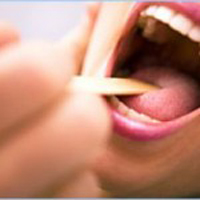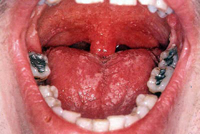Thrush (Candidiasis)
What Is It? 
Thrush is the common name for a mouth infection caused by an overgrowth of the Candida fungus. This fungus normally lives in many people's mouths. Thrush is a surface infection. It can affect the corners of the mouth, the insides of the cheeks, the tongue, roof of the mouth (palate) and throat.
Thrush is common in babies. A newborn may acquire the Candida fungus during delivery, if its mother had an active yeast infection in the vagina. Symptoms of thrush usually follow within 7 to 10 days after birth. Babies with the infection may pass it on to their mothers while nursing. Then the mother and baby pass it back and forth. The mother may feel pain upon nursing and pain deep inside the breast. Nipples may be unusually red or sensitive. Tell your physician if you have these symptoms.
In older children or adults, thrush is triggered most often by:
- Diseases or drugs that affect the immune system
- Cancer chemotherapy
- Steroid therapy
- Treatment with antibiotics
Antibiotics trigger thrush by killing the mouth's normal population of bacteria. Once these normal bacteria are gone, Candida can grow without competition. People with dry mouth have less saliva and are more prone to developing thrush. Many medicines, both prescription and over-the-counter, can cause dry mouth. Tell your physician and dentist about of all the medicines you take. Be sure to include both prescription and over-the-counter medicines. 
Certain people are more likely to get thrush. Examples include people who wear complete dentures, people with diabetes, and the elderly and debilitated. People who are malnourished have a higher risk of thrush. So do people with illnesses that weaken immune defenses, such as cancer or HIV infection.
Symptoms
The first symptoms may be a bad taste in the mouth and decreased taste sensation. Thrush causes white patches, with a texture similar to cottage cheese, inside the mouth. They are found most commonly on the tongue, roof of the mouth, back of the throat and corners of the mouth. If you try to scrape off the whitish surface of a patch, you will usually find a red, inflamed area underneath. It may bleed slightly. You also may have cracked, red, moist areas of skin at the corners of the mouth.
Sometimes thrush patches are painful, but often they are not. Infants who have painful patches may be fussy, irritable and feed poorly.
Diagnosis
Your dentist or physician usually diagnoses thrush by looking in your mouth. He or she will try to scrape off any white patches with a tongue blade or gauze pad. If the diagnosis is in question, your physician or dentist also may send a sample of these scrapings to a laboratory for testing. In certain cases, a biopsy is needed. In this procedure, a small piece of skin is removed and examined in a laboratory.
In most patients, this is all that needs to be done for diagnosis. However, if you get thrush often or it doesn't go away, you may have an undiagnosed medical illness. Diabetes, cancer and HIV infection are all possible causes. In this case, blood tests or other types of tests may be needed. Your physician or dentist will ask about your history of these illnesses and about recent drug therapy.